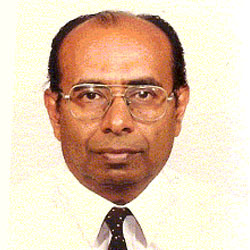
Emeritus PROFESSOR
Visiting Senior Professor, College of Chemical Sciences, Institute of Chemistry Ceylon,
and
Emeritus Professor, The University of the South Pacific, Fiji
Biography
Professor S. Sotheeswaran obtained his B. Sc Honours degree in Chemistry from the University of Ceylon in 1963 and a Doctor of Philosophy (Ph.D.) and Doctor of Science (D. Sc.) degrees from the University of Hull, United Kingdom, in 1967 and 1987 respectively.
Most of his childhood was spent in Palapathwela near Matale where his father was a Head Master of a School. He had his secondary school education at St Peter’s College, Bambalapitiya, St. Thomas College, Matale, and Hartley College, Point Pedro.
Sotheeswaran spent four years at the University of Ceylon and was awarded a first class honours degree in Chemistry. He also won the Bhikaji Framjee Khan Gold medal for the best performance at the final B. Sc. Honours degree examination held in 1963.
He was selected as a staff member to the University of Peradeniya’s new Science Faculty, which was established in 1961. While at Peradeniya, Sotheeswaran was awarded a Commonwealth Scholarship to undertake postgraduate research at a British University (University of Hull, UK) in 1964.
After obtaining his Ph. D degree, Dr Sotheeswaran returned to the University of Peradeniya in 1967 and assumed duties as a lecturer in chemistry. He was subsequently promoted as senior lecturer and later rose to the rank of associate professor in chemistry.
During 1979-1981, Dr Sotheeswaran was involved in two research projects funded by the World Health Organisation (WHO) based in Geneva, Switzerland. He was invited to attend WHO Research meetings in Geneva, Jena (in the then East Germany), Seoul and Singapore.
Dr Sotheeswaran spent his sabbatical leave periods away from the University of Peradeniya at the Chemistry Departments at the University of Tasmania, Australia (1973/1974), and Dalhousie University in Halifax, Nova Scotia, Canada (1982/1983). He also spent short periods at Mahidol University in Thailand during July/September 1982 and at the Uniersity of Hohenheim 1985 1nd 1989.
In 1985, Professor Sotheeswaran moved to the South Pacific and was later appointed as the Professor of Organic Chemistry and Head of the Chemistry Department at the University of the South Pacific. In 1988, Professor Sotheeswaran was a research fellow at the Research School of Chemistry, Australian National University in Canberra, Australia.
Professor Sotheeswaran was also a visiting professor at the Chemistry Department in Waikato University in Hamilton, New Zealand in 1996.
During 2001-2004, Professor Sotheeswaran functioned as an External Examiner for the B. Sc Honours in Chemistry at the University of Peradeniya and was invited by the Sri Lankan Ministry of Science and Technology to Peradeniya the University of Peradeniya to conduct workshops and deliver lectures for two months in 2001/2002.
In 2006, Professor Sotheeswaran was appointed as the Foundation Professor of Chemistry at the College of Chemical Sciences, Institute of Chemistry Ceylon whilst on leave without pay and sabbatical leave from the University of the South Pacific based in the Fiji Islands.
Title of the Speech
“Anti-diabetic Medications from Tropical Plants.”
Abstract
Diabetes results from a lack or shortage of insulin, a hormone necessary to metabolise carbohydrates. Consequently, sugar accumulates in the blood. Diabetes cannot be cured but can be controlled. Today, there are medications to induce the pancreas to produce more insulin. If the pancreas does not respond to this inducement, the patient can be given insulin injection. Patients are also advised to adopt a diet low in carbohydrates.
Indigenous physicians in India, Fiji and Sri Lanka have used herbal treatments for diabetes for centuries. It is interesting that most of these treatments are foodstuffs that are taken by everyone. Animal trials have proved that herbal medication is indeed effective against diabetes. Some of the traditional herbal remedies for diabetes, their common and/or local names and their Botanical names (in parenthesis) are :
(1) Bitter Gourd/Bitter Melon/Pavatkai – (Momordica charantia),
(2) Fenugreek/Venthayam ( Trigonella foenum-graecum) ,
(3) Kurincha (Gymnema species),
(4) Cinnamon/Karuva (Cinnamomum species),
(5) Tebu (Costus speciosus), and
(6) Kothala Himbutu (Salacia reticulata).
Of these, plants 1, 2 and 4 are incorporated in a herbal anti-diabetic pharmaceutical called Glucobetic. This lecture discuses some herbal anti-diabetic remedies, and questions the dosages and effectiveness (or otherwise) of these plant medications in Glucobetic. Even though there are no clinical trial data published for herbal anti-diabetic medications, preliminary clinical trial data on the use of cinnamon bark in reducing the blood sugar levels of diabetic patients are currently available and will be presented at this lecture.
